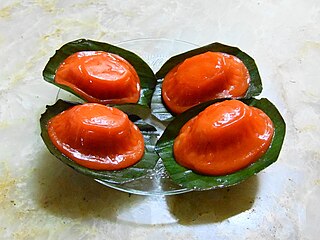
A crêpe or crepe is a very thin type of pancake. Crêpes are usually one of two varieties: sweet crêpes or savoury galettes. They are often served with a wide variety of fillings such as cheese, fruit, vegetables, meats, and a variety of spreads. Crêpes can also be flambéed, such as in crêpes Suzette.

A wedding cake is the traditional cake served at wedding receptions following dinner. In some parts of England, the wedding cake is served at a wedding breakfast; the 'wedding breakfast' does not mean the meal will be held in the morning, but at a time following the ceremony on the same day. In modern Western culture, the cake is usually on display and served to guests at the reception. Traditionally, wedding cakes were made to bring good luck to all guests and the couple. Nowadays, however, they are more of a centerpiece to the wedding and are not always even served to the guests. Some cakes are built with only a single edible tier for the bride and groom to share, but this is rare since the cost difference between fake and real tiers is minimal.

A mooncake is a Chinese bakery product traditionally eaten during the Mid-Autumn Festival (中秋節). The festival is primarily about the harvest while a legend connects it to moon watching, and mooncakes are regarded as a delicacy. Mooncakes are offered between friends or on family gatherings while celebrating the festival. The Mid-Autumn Festival is widely regarded as one of the four most important Chinese festivals.

A mille-feuille, also known by the names Napoleon in North America, vanilla slice in the United Kingdom, and custard slice, is a French dessert made of puff pastry layered with pastry cream. Its modern form was influenced by improvements made by Marie-Antoine Carême.

German chocolate cake, originally German's chocolate cake, is a layered chocolate cake filled and topped with a coconut-pecan frosting. Originating in the United States, it was named after English-American chocolate maker Samuel German, who developed a formulation of dark baking chocolate that came to be used in the cake recipe. Sweet baking chocolate is traditionally used for the cake's flavor, but few recipes call for it today. The filling and/or topping is a custard made with egg yolks and evaporated milk; once the custard is cooked, coconut and pecans are stirred in. Occasionally, a chocolate frosting is spread on the sides of the cake and piped around the circumference of the layers to hold in the filling. Maraschino cherries are occasionally added as a garnish.

Cobbler is a dessert consisting of a fruit filling poured into a large baking dish and covered with a batter, biscuit, or dumpling before being baked. Some cobbler recipes, especially in the American South, resemble a thick-crusted, deep-dish pie with both a top and bottom crust. Cobbler is part of the cuisine of the United Kingdom and United States, and should not be confused with a crumble.

A Krapfen is a German jam doughnut with no central hole, made from sweet yeast dough fried in lard or cooking oil, with a jam filling, and usually covered in powdered sugar.

A Swiss roll, jelly roll, roll cake, cream roll, roulade or Swiss log is a type of rolled sponge cake filled with whipped cream, jam, icing, or any type of filling. The origins of the term are unclear; in spite of the name "Swiss roll", the cake is believed to have originated elsewhere in Central Europe, possibly Austria or Slovenia. It appears to have been invented in the nineteenth century, along with Battenberg cake, doughnuts, and Victoria sponge. In the U.S., commercial snack-sized versions of the cake are sold with the brand names Ho Hos, Yodels, Swiss Cake Rolls, and others. A type of roll cake called Yule log is traditionally served at Christmas.

A cremeschnitte, also known as vanilla slice or custard slice, is a custard and chantilly cream cream cake dessert commonly associated with the former Austro-Hungarian Monarchy. However, its exact origin is unknown. This dish remains popular across Central Europe and the Balkans in various variations, all of which include a puff pastry base and custard cream.

A rice cake may be any kind of food item made from rice that has been shaped, condensed, or otherwise combined into a single object. A wide variety of rice cakes exist in many different cultures in which rice is eaten. Common variations include cakes made with rice flour, those made from ground rice, and those made from whole grains of rice compressed together or combined with some other binding substance.

Pionono describes different sweet or savory pastries from Granada, Spain, the Philippines, South America, and the Caribbean. It is named after Pope Pius IX's name in Spanish, Pío Nono.

Princess cake is a traditional Swedish layer cake or torte consisting of alternating layers of airy sponge cake, pastry cream, and a thick-domed layer of whipped cream. The cake is covered by a layer of rolled marzipan, giving it a smooth, rounded top. The marzipan overlay is usually green, sprinkled with powdered sugar, and often decorated with a pink marzipan rose. While the original recipe did not contain any fruit, modern versions usually include layers of jam or fresh fruit, usually raspberries.

Smultring and hjortetakk are cake doughnuts from Norway. They are small and usually prepared without glazing or filling, and are often spiced with cardamom, cinnamon, lemon or orange zest, as well as various liqueurs.

Sponge cake is a light cake made with eggs, flour and sugar, sometimes leavened with baking powder. Some sponge cakes do not contain egg yolks, like angel food cake, but most of them do. Sponge cakes, leavened with beaten eggs, originated during the Renaissance, possibly in Spain. The sponge cake is thought to be one of the first non-yeasted cakes, and the earliest attested sponge cake recipe in English is found in a book by the English poet Gervase Markham, The English Huswife, Containing the Inward and Outward Virtues Which Ought to Be in a Complete Woman (1615). Still, the cake was much more like a cracker: thin and crispy. Sponge cakes became the cake recognised today when bakers started using beaten eggs as a rising agent in the mid-18th century. The Victorian creation of baking powder by English food manufacturer Alfred Bird in 1843 allowed the addition of butter to the traditional sponge recipe, resulting in the creation of the Victoria sponge. Cakes are available in many flavours and have many recipes as well. Sponge cakes have become snack cakes via the Twinkie.

Ang ku kueh, also known as red tortoise cake, is a small round or oval-shaped Chinese pastry with soft, sticky glutinous rice flour skin wrapped around a sweet central filling. It is molded to resemble a tortoise shell and is presented resting on a square piece of banana leaf. As suggested by its name, red tortoise cakes are traditionally red in color and has a sticky, chewy texture when eaten. Red tortoise cakes are shaped like tortoise shells because the Chinese traditionally believed that eating tortoises would bring longevity to those who are eating it and bring about good fortune and prosperity. Considered to be auspicious items, these sweet pastries are especially prepared during important festivals such as Chinese New Year as offerings to the Chinese deities.

Hostess CupCake is an American brand of snack cake produced and distributed by Hostess Brands and currently owned by private equity firms Apollo Global Management and C. Dean Metropoulos & Company. Its most common form is a chocolate cupcake with chocolate icing and vanilla creme filling, with seven distinctive white squiggles across the top. However, other flavors have been available at times. It has been claimed to be the first commercially produced cupcake and has become an iconic American brand.

Međimurska gibanica(pronounced[mɛdʑǐmuːrska'ɡibaŋitsa]; Međimurian layer cake) is a type of gibanica or layer cake originating from Međimurje County, Croatia. It is made of puff pastry and four fillings: nuts, fresh cheese, poppy seeds and apples, as well as of many additional ingredients. It is a traditional dish, especially popular in Northern Croatia, rich in flavour and full of calories, a delicacy which is an integral component of Croatian cuisine.

Pineapple cake is a Taiwanese sweet traditional pastry and dessert containing butter, flour, egg, sugar, and pineapple jam or slices.

A sandwich cookie, also known as a sandwich biscuit, is a type of cookie made from two thin cookies or medium cookies with a filling between them. Many types of fillings are used, such as cream, ganache, buttercream, chocolate, cream cheese, jam, peanut butter, lemon curd, or ice cream.




















